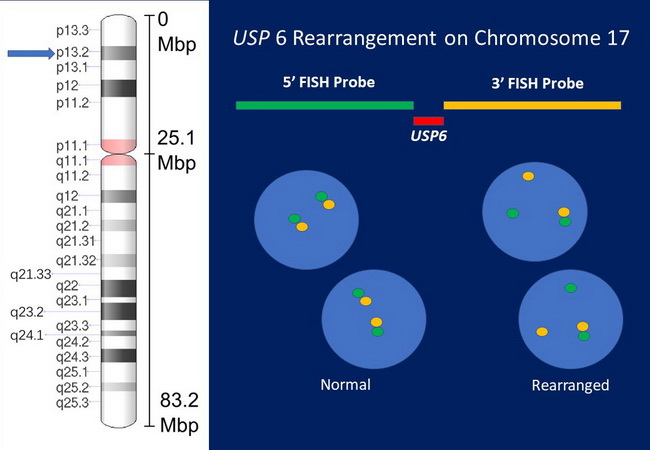Aneurysmal Bone Cyst : USP6 Rearrangement


Comments:
Molecular Genetics: About 70% of aneurysmal bone cysts (ABCs) show rearrangements of USP6 on chromosome 17, most commonly t(16;17)(q22;p13) resulting in fusion of USP6 with CDH11 (the most frequent partner gene). Variant translocations and involved partner genes include: t(1;17) TRAP150, t(3;17) ANF9, t(9;17) OMD, and t(17;17) COL1A1. Several other partner genes have also been implicated in the pathogenesis of ABCs: SPARC, USP9X, SEC31A, EIF1, FOSL2, RUNX2, STAT3, PAFAH1B1, CTNNB1, ANGPTL2, ASAP1, FAT1, SAR1A, and TNC. USP6-CDH11 chimeric protein inhibits maturation of osteoblasts and dysregulates bone morphogenic protein signaling pathway. USP6 rearrangements are not present in ABC-like changes seen with some benign and malignant bone tumors. USP6 rearrangements can be detected by FISH using break-apart probe. In a normal cell (no USP6 rearrangement), the two directly labeled probes hybridize to adjacent areas on 17p13.2 and appear as closely placed orange-green signals in the nucleus. ABC tissue sections with translocation affecting 17p13.2 locus will show one orange-green signal (non-rearranged) and one separate orange and one separate green signal. Variant fusion partners can be detected by NGS fusion assays. The genetic abnormalities are present in the fibroblastic component (spindle cells) of the septa. Other cellular components such as endothelial cells, inflammatory cells including histiocytes, and osteoclast type giant cells do not contain USP6 rearrangements.



